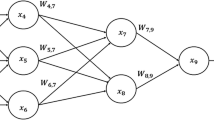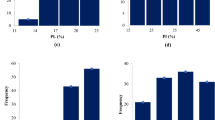Abstract
This paper describes two artificial intelligence techniques for prediction of maximum dry density (MDD) and unconfined compressive strength (UCS) of cement stabilized soil. The first technique uses various artificial neural network (ANN) models such as Bayesian regularization method (BRNN), Levenberg- Marquardt algorithm (LMNN) and differential evolution algorithm (DENN). The second technique uses the support vector machine (SVM) that is firmly based on the theory of statistical learning theory, uses regression technique by introducing ε-insensitive loss function has been adopted. The inputs of both models are liquid limit (LL), plasticity index (PI), clay fraction (CF)%, sand (S)%, gravel Gr (%), moisture content (MC) and cement content (Ce). The sensitivity analyses of the input parameters have been also done for both models. Based on different statistical criteria the SVM models are found to be better than ANN models for the prediction of MDD and UCS of cement stabilized soil.



















Similar content being viewed by others
References
Burroughs VS (2001) Quantitative criteria for the selection and stabilization of soils for rammed earth wall construction. Ph.D. Thesis submitted to University of New South Wales
Das SK, Basudhar PK (2006) Undrained lateral load capacity of piles in clay using artificial neural network. Comput Geotechnics 33(8):454–459
Das SK, Basudhar PK (2008) Prediction of residual friction angle of clays using artifical neural network. Eng Geol 100(3–4):142–145
Goh ATC, Goh SH (2007) Support vector machines: their use in geotechnical engineering as illustrated using seismic liquefaction data. Comput Geotech 34(5):410–421
Goh TC, Kulhawy FH, Chua CG (2005) Bayesian neural network analysis of undrained side resistance of drilled shafts. J Geotech Geoenviron Eng ASCE 131(1):84–93
Horpibulsuk S, Miura N, Nagaraj TS (2003) Assessment of strength development in cement admixed high water content clays with Abrams law as basis. Geotechnique 53(2):439–444
Jarrige JF (1989) Chronology of the earlier periods of the greater as seen from Mehergrah, Pakistan. In: Alichin B (ed) South Asian archaeology. Cambridge University Press, Cambridge, pp 21–28
Kecman V (2001) Learning and soft computing: support vector machines, neural networks, and fuzzy logic models. The MIT press, Cambridge
Liong SY, Lim WH, Paudyal GN (2000) River stage forecasting in Bangladesh: neural network approach. J Comput Civ Eng 14(1):1–8
Miura N, Horpibussuk S, Nagaraj TS (2001) Engineering behavior of cement stabilized clay at high water content. Soils Found 41(5):33–45
Narendra BS, Sivapullaiah PV, Suresh S, Omkar SN (2006) Prediction of unconfined compressive strength of soft grounds using computational intelligence techniques: A comparative study. Comput Geotech 33(3):196–208
Park D, Rilett LR (1999) Forecasting freeway link ravel times with a multi-layer feed forward neural network. Comput Aided Civ Infa Struct Eng 14:358–367
Porbaha A (1998) State of the art in deep mixing technology: part I. Basic concepts and overview. Ground Improv 2(2):81–92
Samui P (2008) Support vector machine applied to settlement of shallow foundations on cohesionless soils. Comput Goetech 35(3):419–427
Samui P, Kurup Pradeep, Sitharam TG (2008) OCR prediction using support vector machine based on piezocone data. J Geotech Geo Environ Eng 134(6):894–898
Scholkopf B (1997) Support vector learning. R. Oldenbourg, Munich
Smola AJ, Scholkopf B (2004) A tutorial on support vector regression. Stat Comput 14:199–222
Tan TS, Goh TL, Yong KY (2002) Properties of Singapore marine clays improved by cement mixing. Geotech Test J ASTM 25(4):422–433
Uddin K, Balasubramaniam AS, Bergado DT (1997) Engineering behavior of cement treated Bangkok soft clay. Geotech Eng J 28(1):89–119
Vapnik VN (1995) The nature of statistical learning theory. Springer, New York
Vapnik VN (1998) Statistical learning theory. Wiley, New York
Yin JH, Lai CK (1998) Strength and stiffness of Hong Kong marine deposit mixed with cement. Geotech Eng J 29(1):29–44
Author information
Authors and Affiliations
Corresponding author
Rights and permissions
About this article
Cite this article
Das, S.K., Samui, P. & Sabat, A.K. Application of Artificial Intelligence to Maximum Dry Density and Unconfined Compressive Strength of Cement Stabilized Soil. Geotech Geol Eng 29, 329–342 (2011). https://doi.org/10.1007/s10706-010-9379-4
Received:
Accepted:
Published:
Issue Date:
DOI: https://doi.org/10.1007/s10706-010-9379-4




